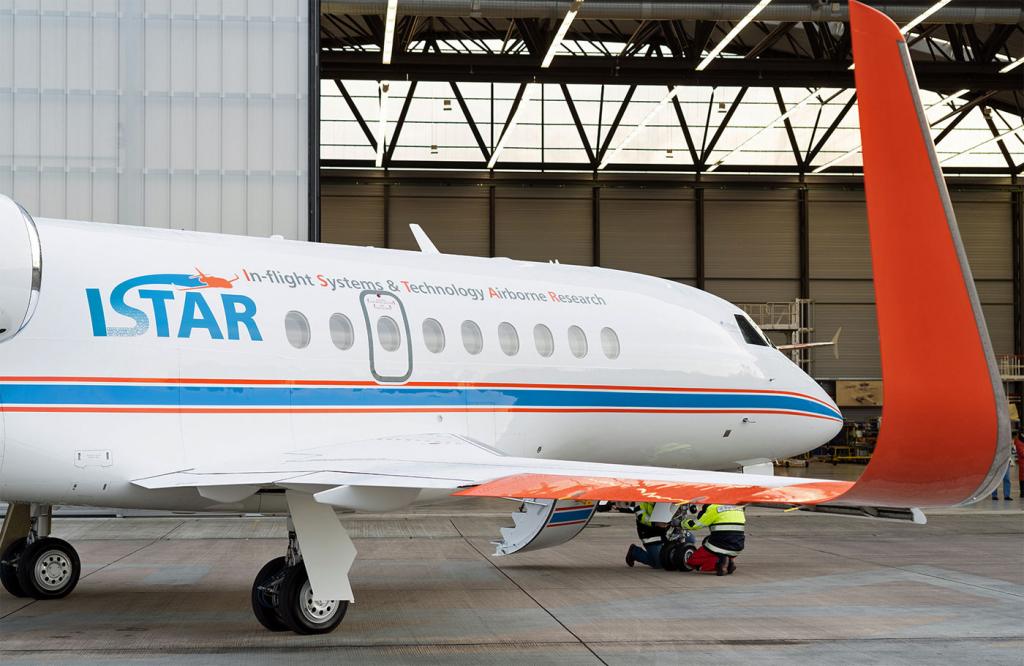The ISTAR research aircraft has begun the scientific operation. ISTAR (Airborne Research Systems and Technologies) flights focus on the flight mechanical and flight dynamics characteristics of a converted Dassault Falcon 2000LX. New sensors measure the aircraft’s behavior during special flight maneuvers. With the results, the German Aerospace Center (DLR) is developing ISTAR’s digital twin and helping make aircraft more energy efficient. The digital twin is the exact virtual image of the aircraft on the computer.
The flight maneuvers and ground tests bring in data from new measurement technologies combined with state-of-the-art simulation tools. The project manager, Dr. Heiko von Geyr from the DLR Institute for Aerodynamics and Flow Technology in Braunschweig. ISTAR should not only be able to test it realistically in a flight simulator. The goal of the HighFly (High Speed Inflight Validation) project is to combine several processes: “This allows us to predict structural deformation, flow and acceleration at any point of ISTAR at any time,” explains Heiko von Geyr. Before researchers can realistically map the aircraft’s behavior on a computer, they need to compare computational models with measurement results and develop further. “Only then can we say that the plane behaves exactly as it does in reality on a computer.”
ISTAR has been taking off from the airport at the DLR’s Braunschweig flight measurement site since the end of February 2023. The aircraft has been converted and prepared for the project for scientific purposes in the past. Almost 400 maneuvers with different speeds, altitudes and dynamics were carried out in reserved airspace at Mecklenburg-Vorpommern. Using a digital twin, future researchers will be able to computer-test new aircraft designs at a relatively early stage and assess whether the changes will affect the aircraft’s characteristics and flight behavior. In addition to virtual flight tests, the scientists also keep in mind simulation-based certifications for the long haul. This could speed up time-consuming and costly approval procedures in aviation.
The HighFly project is looking at changes in flight maneuvers
In order to be able to measure how the flow on the wings changes during various flight maneuvers and how much the wings deform in flight, the researchers applied a pixelated film to the left wing. Close up, the points are partly round and partly elongated. All points look the same for cameras looking at the wing from inside the fuselage at a certain angle. As the wings flex in flight, the cameras record the change in the location of the points. This is how the local deformation of the wing is determined.
Sensors are distributed on and below the right wing. MEMS (Micro Electromechanical System) sensors measure pressure and temperature distribution with high accuracy and high frequency during flight tests. “MEMS is a completely new development as part of the project and is being used here for the first time in the transsonic speed range under real flight conditions,” says Heiko von Geyr. In the transsonic range, the plane flies slower than the speed of sound, but the airflow around the wing profile still reaches supersonic speed in some places. This leads to a very complex flow with pressure shocks, which must be reliably recorded by MEMS sensors.
In addition, three MEMS sensor surfaces are installed near the cockpit. They measure pressure fluctuations in the boundary thin layers created here by the shape of the jet. The MEMS sensor surfaces were developed by the DLR Institute for Aerodynamics and Flow Technology in Göttingen.
valuable database
Test pilots use ISTAR to fly precisely defined maneuvers at 11,000, 25,000, 35,000 and 45,000 feet. This corresponds to altitudes of about 3350, 7620, 10670 and 13720 metres. Computers in the cab store all measured values. The researchers then compared the wealth of data with the results of numerical simulations. Supercomputers such as the DLR’s CARO and CARA clusters are essential for this. “With our measurements, we cover the entire range of transsonic flight right up to the limits of what can be flown. The combination of measurement techniques makes this database so unique and valuable,” explains Heiko von Geyr.
Scientists from the DLR Institute for Aeronautical Systems also performed PID (Parameter Determination Flights) flights as part of the HighFly project. This results in the ISTAR flight dynamics simulation model. This can then be used in a flight simulator such as AVES (Air Vehicle Simulator). “This way, we can first test newly developed flight control and assistance systems in the simulator before we start flight tests with them,” says Christian Raab of the DLR Institute for Flight Systems.
Earth tests for digital twins
On the ground, researchers from the DLR Institute for Aeroelasticity conducted ground vibration testing (GVT) and taxi vibration tests (TVT) in the summer of 2021. Explains Dr. Mark Boswald of the DLR Institute for Aerobic Flexibility. Airplanes do not have a rigid structure. In order to be able to fly safely, flexibility must be considered.
In GVT, the ISTAR is set to vibrate. More than 200 additional sensors have measured and modeled ISTAR interactions. On TVT, ISTAR was pulled over the runway. Uneven ground generates vibrations through the chassis. During the current flights, the scientists also monitored ISTAR’s pneumatic elastomer properties using newly developed methods. In the future, these tests may also be performed using a digital twin.
The DLR Institute of Aerodynamics and Flow Technology also measured flow to the engine using particle image velocity (PIV) measurement for different thrust settings. Engine flow affects the ISTAR’s aerodynamics. The specific data of the digital twin is also provided.
istar
ISTAR (Airborne Systems and Technologies Research) has been part of the DLR research fleet since 2019. It will be expanded in several phases. By mid-2020, it will be fully operational as a flight simulator and will introduce flight digitization. When fully developed, ISTAR will be able to test the properties of new aircraft designs in real or virtual form. The digital twin accompanies ISTAR throughout its entire service life. The research aircraft is based at the DLR flight test site in Braunschweig, where it is part of the largest civilian research fleet in Europe.
Source: PM DLR

“Alcohol buff. Troublemaker. Introvert. Student. Social media lover. Web ninja. Bacon fan. Reader.”






More Stories
Science – Bocking – Blue tits: more unfaithful offspring among older males – Bavaria
Ability to innovate: Research has not lost any of its innovative power
Hypertension, Diabetes & Co: Four Types of Sleep That Often Make You Sick – The World of Sleep